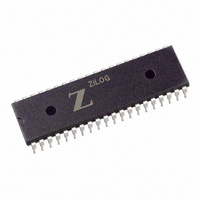Z85C3010PSG Zilog, Z85C3010PSG Datasheet - Page 68

Z85C3010PSG
Manufacturer Part Number
Z85C3010PSG
Description
IC 10MHZ Z8500 CMOS SCC 40-DIP
Manufacturer
Zilog
Series
SCCr
Specifications of Z85C3010PSG
Processor Type
Z80
Features
Error Detection and Multiprotocol Support
Speed
10MHz
Voltage
5V
Mounting Type
Through Hole
Package / Case
40-DIP (0.620", 15.75mm)
Cpu Speed
8MHz
Digital Ic Case Style
DIP
No. Of Pins
40
Supply Voltage Range
5V
Operating Temperature Range
0°C To +70°C
Svhc
No SVHC (18-Jun-2010)
Base Number
85
Rohs Compliant
Yes
Clock Frequency
10MHz
Lead Free Status / RoHS Status
Lead free / RoHS Compliant
Other names
269-3934
Z85C3010PSG
Z85C3010PSG
Available stocks
Company
Part Number
Manufacturer
Quantity
Price
Company:
Part Number:
Z85C3010PSG
Manufacturer:
Zilog
Quantity:
135
Company:
Part Number:
Z85C3010PSG
Manufacturer:
Zilog
Quantity:
326
- Current page: 68 of 317
- Download datasheet (4Mb)
UM010901-0601
3.4 DPLL DIGITAL PHASE-LOCKED LOOP
Each channel of the SCC contains a digital phase-locked
loop that can be used to recover clock information from a
data stream with NRZI, FM, NRZ, or Manchester encod-
ing. The DPLL is driven by a clock nominally at 32 (NRZI)
or 16 (FM) times the data rate. The DPLL uses this clock,
along with the data stream, to construct a receive clock for
the data. This clock can then be used as the SCC receive
clock, the transmit clock, or both.
The clock source for the DPLL is selected issuing one of
the two commands in WR14, that is:
The first command selects the baud rate generator as the
clock source. The other command selects the /RTxC pin
as the clock source, independent of whether the /RTxC pin
is a simple input or part of the crystal oscillator circuit.
Initialization of the DPLL is done at any time during the ini-
tialization sequence, but should be done after the clock
modes have been selected in WR11, and before the re-
ceiver and transmitter are enabled. When initializing the
DPLL, the clock source should be selected first, followed
by the selection of the operating mode.
To avoid metastable problems in the counter, the clock
source selection is made only while DPLL is disabled,
since arbitrarily narrow pulses are generated at the output
of the multiplexer when it changes status.
The DPLL is programmed to operate in one of two modes,
as selected by commands in WR14.
Note: A channel or hardware reset disables the DPLL, se-
lects the /RTxC pin as the clock source for the DPLL, and
places it in the NRZI mode.
WR14 (7-5) = 100 selects the BRG
WR14 (7-5) = 101 selects the /RTxC pin
WR14 (7-5) = 111 selects NRZI mode
WR14 (7-5) = 110 selects FM mode
RxD
Edge Detector
Figure 3-5. Digital Phase-Locked Loop
Count Modifier
5-Bit Counter
Figure 3-5 shows a block diagram of the digital phase-
locked loop. It consists of a 5-bit counter, an edge detector,
and a pair of output decoders. The clock for the DPLL
comes from the output of a two-input multiplexer, and the
two outputs go to the transmitter and receive clock
multiplexers. The DPLL is controlled by seven commands
encoded in WR14 bits D7, D6 and D5.
As in the case of the clock source selection, the mode of
operation is only changed while the DPLL is disabled to
prevent unpredictable results.
In the NRZI mode, the DPLL clock must be 32 times the
data rate. In this mode, the transmit and receive clock out-
puts of the DPLL are identical, and the clocks are phased
so that the receiver samples the data in the middle of the
bit cell. In NRZI mode, the DPLL does not require a transi-
tion in every bit cell, so this mode is useful for recovering
the clocking information from NRZ and NRZI data streams.
In the FM mode, the DPLL clock must be 16 times the data
rate. In this mode, the transmit clock output of the DPLL
lags the receive clock outputs by 90 degrees to make the
transmit and receive bit cell boundaries the same, be-
cause the receiver must sample FM data at one-quarter
and three-quarters bit time.
The DPLL is enabled by issuing the Enter Search Mode
command in WR14; that is WR14 (7-5) = 001. The Enter
Search Mode command unlocks the counter, which is held
while the DPLL is disabled, and enables the edge detector.
If the DPLL is already enabled when this command is is-
sued, the DPLL also enters Search Mode.
SCC/ESCC Ancillary Support Circuitry
SCC™/ESCC™ User’s Manual
Decode
Decode
Receive
Clock
Transmit
Clock
3-7
3
Related parts for Z85C3010PSG
Image
Part Number
Description
Manufacturer
Datasheet
Request
R

Part Number:
Description:
Manufacturer:
Zilog, Inc.
Datasheet:

Part Number:
Description:
Cmos Scc Serial Communications Controller
Manufacturer:
ZiLOG Semiconductor
Datasheet:

Part Number:
Description:
Communication Controllers, ZILOG INTELLIGENT PERIPHERAL CONTROLLER (ZIP)
Manufacturer:
Zilog, Inc.
Datasheet:

Part Number:
Description:
KIT DEV FOR Z8 ENCORE 16K TO 64K
Manufacturer:
Zilog
Datasheet:

Part Number:
Description:
KIT DEV Z8 ENCORE XP 28-PIN
Manufacturer:
Zilog
Datasheet:

Part Number:
Description:
DEV KIT FOR Z8 ENCORE 8K/4K
Manufacturer:
Zilog
Datasheet:

Part Number:
Description:
KIT DEV Z8 ENCORE XP 28-PIN
Manufacturer:
Zilog
Datasheet:

Part Number:
Description:
DEV KIT FOR Z8 ENCORE 4K TO 8K
Manufacturer:
Zilog
Datasheet:

Part Number:
Description:
CMOS Z8 microcontroller. ROM 16 Kbytes, RAM 256 bytes, speed 16 MHz, 32 lines I/O, 3.0V to 5.5V
Manufacturer:
Zilog, Inc.
Datasheet:

Part Number:
Description:
Low-cost microcontroller. 512 bytes ROM, 61 bytes RAM, 8 MHz
Manufacturer:
Zilog, Inc.
Datasheet:

Part Number:
Description:
Z8 4K OTP Microcontroller
Manufacturer:
Zilog, Inc.
Datasheet:

Part Number:
Description:
CMOS SUPER8 ROMLESS MCU
Manufacturer:
Zilog, Inc.
Datasheet:

Part Number:
Description:
SL1866 CMOSZ8 OTP Microcontroller
Manufacturer:
Zilog, Inc.
Datasheet:











